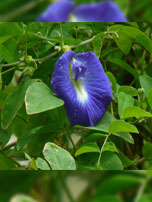SHAHEED KARTAR SINGH SARABHA AYURVEDIC MEDICAL COLLEGE & HOSPITAL
Affiliated to Guru Ravidas Ayurved University, Hoshiarpur Punjab
Affiliated to Guru Ravidas Ayurved University, Hoshiarpur Punjab

Botanical Name : Clitoria ternatea Linn
Family : Papilionaceae; Fabaceae.
Introduction :
This plant’s root is specially used for leucoderma. It is also considered as Visahara. Brhat Trayi texts do not come across the term Aparãjita. However it is found in one contest in Su. U.
Names in different Indian languages :
Hindi : Aparajita
English : Clitoria
Telugu : Dintena
Tamil : Kannikotti, Girikarnika
Malayalam : sangu pushpam, Aral,Malayamukki
Kanada : Shankapuspa, Karnika
Unnani : Mezereon
Folk : Koyal ( Punjab)
Synonyms :
Asphota, Girikarni, Visnukrãntã, sankhapuspi, Sephanda, svetã, Mahã svetã
Bavaprakash , dhanvatarinighandu, raja nighandu – 3 varieties
1. Aparajitha
2. Girikarnika
3. Adrikarni
Classification according to Charaka, Susrutha & Vagbhata :
Charaka
Sirovirechanopaga
Varieties & adulterants – (CV – controversy, AD – adulterants) :
1. blue flowers
2. white flowers ( Both are identified as C. ternatea Linn. )
3. Sveta aparajitha – sreyi now it identified as Rasna
4. mahasevta aparajitha
5. katabhi – Albizza procera
6. Ksudra Sveta – C. ternatea
7. Canscora decussate [AD]
8. convolvulus pluricaulis [AD]
9. Evolvulus alsinodes [AD]
10. sankhini and sankapushpi
In north india, sankapushpi used as Canscora decussate
Morphology :
It is a perennial climber – Herb.
Leaves- compound,pinnate 5-9 foliolate.
Flowers- showy, blue or white, petals unequal, style bearded below the stigma.
Fruits- pods, linear, compressed.
Seeds- 6-10, yellowish brown (Flowers in rainy season and fruits in winter).
Distribution & Habitat :
All over India
Chemical constituents :
Aparajitin, taraxerol, taraxerone, a— and I— sitosterols, robinin, quercetin, kaempferol; ternatins,
Properties :
Rasa- Katu, Tikta, Kasaya
Guna- Laghu, Rüksa
Virya-Sita
Vipãka- Katu
Karma :
Tridosahara, Medhya, Visaghna, Cakusya
Root—cathartic like jalap. Roots cause gripe and tenesmus, hence not recommended as purgative. Used in ascites.
Rootbark—diuretic (infusion used in irritation of bladder and urethra).
Root juice—given in cold milkto liquefy phlegm in chronic bronchitis.
The root, bark, seeds and leaves—used for gastric acidity.
External uses :
It alleviates swelling and pain. It has haemostatic action hence it is ued in piles specially bleeding piles. Piles are cleaned with the decoction and the paste of whole plant is applied over it. Leaf juice is used as nasal drops in headache. Oil boiled with dhamasa is used for massage in rheumatoid arthritis.
Decoction is used for gargling in stomatitis and for cleaning wounds. It prevents pus formation
Internal uses :
Nervous system : It has a tranquillizing effect on the brain hence it is used in symptoms like syncope, vertigo and brain weakness.
Digestive system : It is an antiemetic. mild-laxative and cholagogue Therefore it is used in emesis. dyspepsia, constipation jaundice and piles. Kapha and pitta work together in the lower part of the stomach. It is used in healing ulcers of pylorus duodenum etc.
Circulatory system : Being haemostatic and blood purifier, it is useful in haemorrhagic disorders and vatarakta. Hot infusion of dhamasa is given to prevent small pox.
Respiratory system: It is used in common cold, cough, asthma as it acts as an expectorant and reduces the irritation of respiratory organs. Besides this, whole plant is used for smoking. Decoction is used for gargling in throat manifestations
Mansavaha srotas : Paste of this applied over neck stiffness.
Urinary system : It increases urination. Decoction is used in dysuria.
Reproductive system : Being spermatogenic, it is given in semen debility.
Skin : It can be used in various skin disorders by.
Temperature: Febrifuge and refrigerant by bitter and cold properties. Bitter taste is the best for fever. It can be used for cooling effect. It alleviates symptoms like vomiting, thirst and burning sensation etc. which are caused by vata and kapha in fever.
Satmikaran: It increases the physical strength and weight
Indications :
Kustha, Unmãda, Vrana, süla, ascites. , diuretic , bronchitis, Brian tonic, tubular glands, diuretic, amentia, ophthalmic, Hemorrhoids, migraine, psychoneurosis and mania.
Roots – Laxative but not used as purgative because it causes gripe and tenesmus
Part Used :
Root/root bark, seeds , leaves
Dosage :
Root powder 2-3g,
seed powder 1-2 g.
Important Yogas or Formations:
Garbhapalaras
Therapeutic Uses:
(1) Dañta süla- Root of Aparãjita along with Marica is kept in the mouth.
(2) Sopha- Paste of Girikarnikã leaves is used internally/orally (V.S.).
(3) Manasaroga- Root of white flowered Aparãjitã is pounded with rice-water and used as Nasya by mixing with ghee (R. M.).
(4) The root is administered with honey as a general tonic to children for improving mental faculty.
